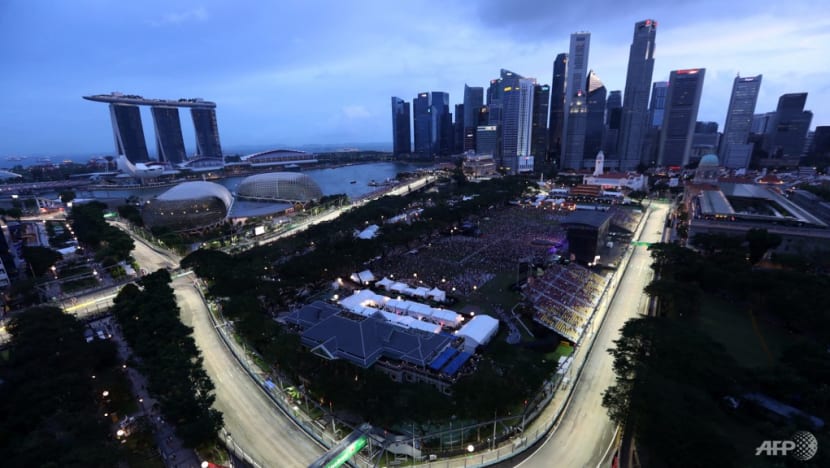F1 Singapore GP makes efforts to go green
Based on a report released by F1 in 2019, the total emission of a single season is estimated to be more than 256,000 tonnes of carbon dioxide – about the same amount emitted by some countries.

FILE: The skyline of Singapore is seen over the Marina Bay Street Circuit before the start of the Formula 1 Singapore Grand Prix on Sep 17, 2017. (File photo: AFP)
SINGAPORE: Competition during the Formula One Singapore Grand Prix (GP) this year will not just be on the race track, but also in sustainability ratings.
Organisers of the event aim to make Singapore feature among the most environmentally sustainable street circuits on the race calendar by the end of the Singapore GP's seven-year term with F1.
To that end, there will be an audit on the event's carbon footprint for the first time.
"This is the first year that we're holding ourselves fully accountable by doing a carbon footprinting report. This is in hopes of developing a plan that will assist us to reach our goal of being one of the most environmentally sustainable street circuits by the end of the seven-year term,” Singapore Grand Prix director of sustainability Sasha Rafi told CNA.
The organiser’s efforts are in line with F1's goals. In 2019, F1 launched a countdown to reaching net-zero carbon by 2030 and hosting sustainable races by 2025.
Based on a report released by F1 in 2019, the total emission of a single season is estimated to be more than 256,000 tonnes of carbon dioxide – about the same amount emitted by some entire countries.
The biggest culprit is logistics. Transporting all the vehicles and equipment around the world accounts for almost half of total emissions, followed by business travel associated with the sport and F1-related factories and facilities.
GREEN CHANGES THIS YEAR
In Singapore, among the initiatives this year is the sale of water in recyclable cartons instead of single-use plastic bottles. There will also be 17 water refilling stations, more than double that of previous years.
Single-use plates and cups available at the event will also be different from the typical ones that are known to leave a larger carbon footprint.
Instead, the disposable tableware – made with plant-based material and provided by local startup TRIA – will be collected after use and converted into fertiliser.
“It is digestible, it can be broken down. So we further put it through our digestion technology, we can accelerate the pace rapidly, to the extent (it) can be turned into fertiliser,” said TRIA’s chief executive Ng Pei Kang.
Fertiliser producer Yara International is exploring ways to make TRIA’s fertiliser suitable for use in farming. Given that the firm’s organic fertiliser is low in nutrient density, it needs to be mixed with chemical fertiliser to give it value in the agricultural industry.
Mr Werner Prinsloo, director of Sustainability & Food Chain in Africa & Asia at Yara International, explained why his firm is eyeing TRIA’s fertiliser.
“There is no need to separate anything. And that allows us to have a more consistent organic mineral fertiliser in the end. So it's just really the ease of use and the fact that they are truly a circular packaging company,” he said.
The food and beverage kitchens in the circuit are also going green. Used cooking oil from the event will be collected and converted into a cleaner form of fuel, which will then be trialled to power a generator this year.
Mr Jack Ling, chief operations officer of Alpha Biofuels, which is turning the oil into a cleaner alternative, said that while Singapore may not have natural resources, there are ways to work around it.
“Although we don't have farm plantations, or soybean, or cornfields, we do have a lot of hawker centers and restaurants and five-star hotels. So used cooking oil is actually a resource in Singapore,” he said.
CAN F1 TRULY BE SUSTAINABLE?
An expert CNA spoke with said the measures in place to make the event more sustainable are comprehensive, but there are aspects that organisers could look at in the future.
“What they're addressing is what I call the trackside … externalities and it is pretty much comprehensive as far as I can see,” said Professor Vish Viswanathan, director of the Nanyang Technological University’s Centre for Business Sustainability.
However, he gave an example of aspects that remain unaddressed, such what happens to the tyres used during the event.
“How are they disposed of properly? Are they working with some tyre company to ensure that as much of circularity is maintained in the tyres because circularity of the tires is probably more relevant than the circularity of the food waste,” he said.
He is optimistic that when it comes to trackside emissions, organisers can set and reach net zero impact in the next three to seven years.
The Singapore Grand Prix organisers are working to make such targets come true. By next year, solar panels will be installed on top of the pit building.
Organisers are also aiming to use energy-efficient LED lighting throughout the track.


















